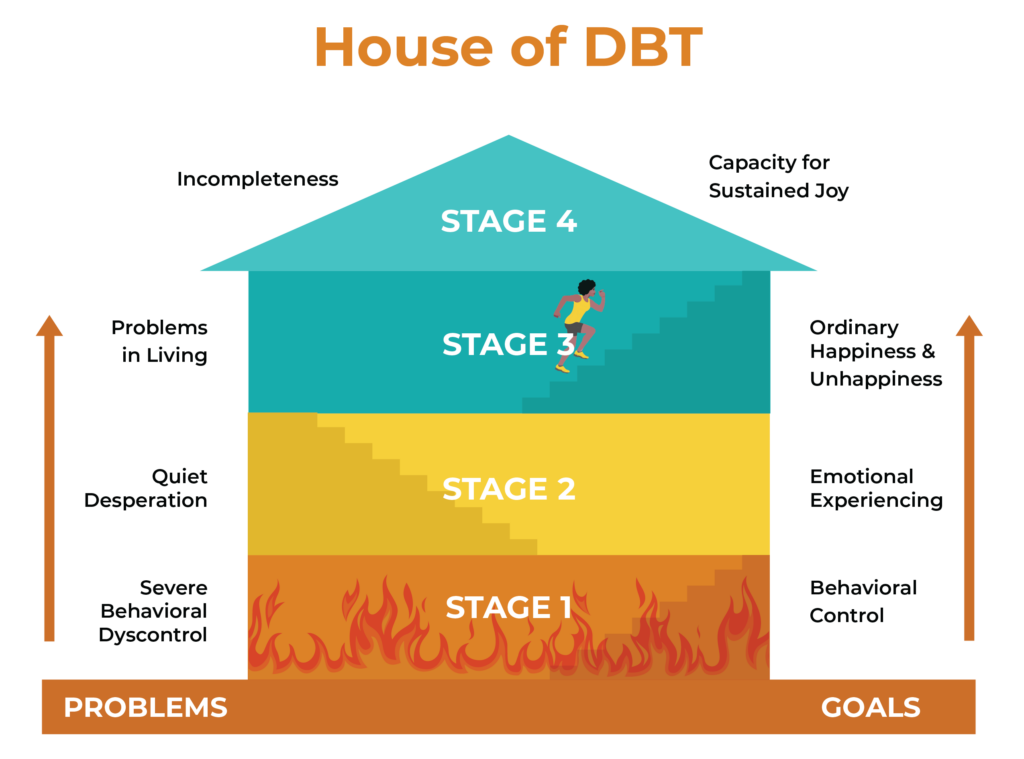
Author: Dr. Christopher Deussing
Many individuals (even well-trained therapists) are unaware that there are multiple stages in Dialectical Behavior Therapy (DBT) & view it as monolithic.
Stage 1 DBT focuses on safety & crisis intervention. Stage 1 clients struggle with life-threatening behaviors (e.g., self-harm, suicidality), treatment-interfering behaviors (e.g., missing appointments), & crisis situations (e.g., losing housing) (Linehan, 2015).
Stage 1 clients often communicate that they have hit rock bottom. Stage 1 aims for problematic behavioral control. The justification for this emphasis on behavioral control is that an out-of-control existence is tortuous & unsustainable (Linehan, 2015). Progress on deeper issues is impossible until one commits to therapy & has skills to regulate emotions without resorting to self-harm (Swales, 2018).
Linehan states: “In [Stage 1], the focus is to get behavioral control … Out-of-control behaviors constitute those that are disordered due to the severity of the disorder or resulting from having multiple diagnoses, such as the suicidal borderline client with co-morbid panic disorder & depression … [The focus of Stage 1] is keeping the patient alive in the treatment setting & gaining required skills & quality of life necessary to work on any further goals” (Knowlton, 1999).
Stage 2 DBT progresses beyond behavioral stabilization, focusing on healthily exposing clients to their pain & letting them experience emotions instead of suppressing them. In Stage 2, behaviors are stabilized, but mental illness is still present (Linehan, 2015). For those with PTSD, this is where past trauma is explored & maladaptive thoughts, beliefs, & behaviors are identified.
The primary goal of Stage 2 is the reduction of traumatic stress. This is achieved by accepting facts of earlier traumatic events, decreasing stigmatization, working through denial, & resolving dialectical tensions regarding who to blame (Linehan, 2015). PTSD is only worked on when behavior is under control. Another Stage 2 goal is the mitigation of desperation by increasing clients’ ability to have a range of emotions without being overwhelmed (Swales, 2018).
Once traumatic stress decreases, Stage 3 DBT focuses on solving problems of everyday living, improving “ordinary” happiness, & sustaining stabilization. Stage 3 also focuses on behavioral accountability, building clients’ trust in themselves, strengthening self-worth, & enhancing quality of life through reasonable goal setting (Linehan, 2015).
Stage 4 (advanced) DBT focuses on transcendence & joy. Stage 4 clients improve upon learned skills & may work on spiritual fulfillment. The goal of Stage 4 is to help clients achieve & maintain ongoing happiness & success (Pederson, 2015).
Resources:
Photo Credit: Sunrise Residential Treatment Center
Knowlton, L. (1999). Marsha Linehan: DBT. Psychiatric Times.
Linehan, M. (2015). DBT skills training manual.
Pederson, L. (2015). DBT: A contemporary guide.
Swales, M. (Ed.). (2018). The Oxford handbook of DBT.